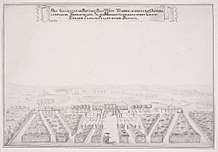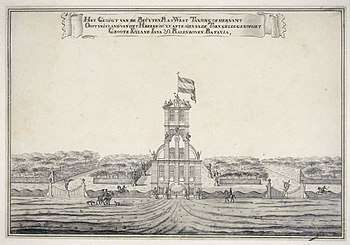Tan Liok Tiauw
| Tan Liok Tiauw Sia | |
|---|---|
| Born |
1872 Batavia, Dutch East Indies |
| Died |
1947 (aged 74–75) Batavia, Dutch East Indies |
| Occupation | landlord, plantation owner, industrialist |
| Years active | 1890s-1940s |
| Home town | Batavia and Tangerang |
| Children |
Corry Tan Pouw Nio (daughter) August Tan Tsjiang Kie (son) Jan Tan Tsjiang Bie (son) |
| Parents |
|
| Family |
Loa Sek Hie (son-in-law) Khouw Yauw Kie, Kapitein der Chinezen (brother-in-law) Tan Eng Goan, Majoor der Chinezen (great-grandfather) |
Tan Liok Tiauw Sia (1872 - 1947) was a prominent Chinese-Indonesian landlord, as well as a pioneering plantation owner and industrialist in the late colonial period.[1][2] He was the last Landheer (or landlord) of Batoe-Tjepper, today's district of Batuceper.[3][4]
History
Family background
Born in Batavia, Dutch East Indies in 1872, Tan hailed from a family of landlords and Chinese officers, part of the Cabang Atas (or Chinese gentry) of colonial Indonesia.[2] The Chinese officership was a high-ranking government position in the civil bureaucracy of the Dutch East Indies (see 'Kapitan Cina').[5]
His father, Tan Tiang Po, served as Luitenant der Chinezen in Tangerang from 1877 until 1885, while his grandfather, Luitenant Tan Kang Soey, sat on the Chinese Council of Batavia ('Kong Koan').[6][7][2] Tan's paternal great-grandfather was the tycoon Tan Leng (died in 1851), who was part of the powerful Ngo Ho Tjiang opium partnership.[8][9] Through his mother, Lim Hong Nio, Tan was a grandson of Lim Soe Keng Sia and Tan Bit Nio, as well as a great-grandson of Tan Eng Goan, first Majoor der Chinezen of Batavia (1802-1872).[2] As a descendant of Chinese officers, Tan Liok Tiauw held the hereditary title of Sia from birth.[10]
Tan's sister, Tan Him Nio, was married to Khouw Yauw Kie, Kapitein der Chinezen (died in 1908).[2] His daughter, Corry Tan Pouw Nio (1900-1961), was married in November 1917 to the prominent, half-Austrian, colonial politician Loa Sek Hie (1898-1965).[11][12][2] He also had two sons born to two different concubines: August Tan Tsjiang Kie and Jan Tan Tsjiang Bie.[2]
Life


Tan grew up on the family's principal private domain, the particuliere landerij of Batoe-Tjepper, an agricultural estate in Tangerang.[12][3] He was given a traditional Chinese education, but also had a Dutch tutor.[12]
After taking over the management of Batoe-Tjepper from his father in 1888, Tan - aged only 16 - further developed an existing factory that manufactured building materials, roof-tiles and other terracotta products.[2][3] Many important colonial buildings in Java, in particular in Batavia, were built using materials from Tan's factory.[13][14][15] In July 1923, Tan welcomed Dirk Fock, the 30th Governor-General of the Dutch East Indies at Batoe-Tjepper as part of the latter's official visit to Tangerang.[16]
In addition, Tan inherited a great deal of other agricultural landholdings from his father, Luitenant Tan Tiang Po, who died in 1912.[17][18] These landholdings were consolidated in the eponymous firm N.V. Landbouw Maatschappij Tan Tiang Po.[19] The company controlled the private domains of Rawa Buaya, Tanah Kodja, Pondok Kosambi, Minggoe Djawa and Kapoek, stretching from the western part of modern-day Jakarta to Tangerang.[4] A wide range of crops were grown on these estates, from rice, coconut and vegetables, and on to grass.[4]
Tan was further involved in a number of new ventures. Together with the philanthropist O. G. Khouw (his brother-in-law's cousin) and D. N. van Stralendorff, Tan acquired the tea and rubber estates of Tendjo Ayoe and Perbakti in the Preanger highlands.[20][21][22] As Director, Tan Liok Tiauw also headed a syndicate of landlords, N. V. Landbouw Maatschappij Tandjong West, which purchased the old, eighteenth-century ‘particuliere land’ or estate of Tandjong West, today part of Jagakarsa in South Jakarta.[23][24]
And beyond Java, Tan played a significant role as a pioneering plantation owner in Lampung on the southern tip of Sumatra, having acquired the formerly struggling British-owned Lampong Coconut Estates, Ltd.[25] These Sumatran estates were run by professional European managers, and grew coconut and pepper.[25]
Tan died in 1947 in Batavia, was buried at his family cemetery at Kebon Besar in Batoe-Tjepper, Tangerang.[2]
References
- ↑ Setyautama, Sam (2008). Tokoh-tokoh etnis Tionghoa di Indonesia (in Indonesian). Jakarta: Kepustakaan Populer Gramedia. ISBN 9789799101259.
- 1 2 3 4 5 6 7 8 9 Haryono, Steve (2017). Perkawinan Strategis: Hubungan Keluarga Antara Opsir-opsir Tionghoa Dan 'Cabang Atas' Di Jawa Pada Abad Ke-19 Dan 20. Steve Haryono. ISBN 9789090302492. Retrieved 16 August 2018.
- 1 2 3 "Batoe Tjeper Cultuur". www.colonialbusinessindonesia.nl. Retrieved 29 December 2017.
- 1 2 3 Regeeringsalmanak voor Nederlandsch-Indië (in Dutch). Landsdrukkerij. 1933.
- ↑ Lohanda, Mona (1996). The Kapitan Cina of Batavia, 1837-1942: A History of Chinese Establishment in Colonial Society. Djambatan. ISBN 9789794282571. Retrieved 5 April 2018.
- ↑ Almanak van Nederlandsch-Indië voor het jaar 1861 (in Dutch). Batavia: Lands Drukkery. 1861.
- ↑ Regeerings-almanak voor Nederlandsch-Indie (in Dutch). Batavia. 1881. Retrieved 19 September 2018.
- ↑ Pax Benedanto; Marcus A. S. (2012). Kesastraan Melayu Tionghoa 5 (in Indonesian). Jakarta: Kepustakaan Populer Gramedia. ISBN 9789799023759. Retrieved 19 September 2018.
- ↑ Chen, Menghong (2011). De Chinese gemeenschap van Batavia, 1843-1865: een onderzoek naar het Kong Koan-archief (in Dutch). Amsterdam: Amsterdam University Press. ISBN 9789087281335. Retrieved 19 September 2018.
- ↑ Blussâe, Lâeonard; Chen, Menghong (2003). The Archives of the Kong Koan of Batavia. Leiden: BRILL. ISBN 9004131574.
- ↑ "Familiebericht". Het nieuws van den dag voor Nederlandsch-Indië (269). NV Mij tot Expl. van Dagbladen. 14 November 1917.
- 1 2 3 Suryadinata, Leo (2015). Prominent Indonesian Chinese: Biographical Sketches (4th edition). Institute of Southeast Asian Studies. ISBN 9789814620505.
- ↑ "Sistem Registrasi Nasional Cagar Budaya". cagarbudaya.kemdikbud.go.id. Kementrian Pendidikan dan Kebudayaan (Ministry of Education and Culture).
- ↑ Mulyani, Ade (2011). Jakarta: panduan wisata tanpa mal (in Indonesian). Jakarta: Gramedia Pustaka Utama. ISBN 9789792258202.
- ↑ Kompas Cyber Media. "Mengenal Perbankan Masa Lalu - Kompas.com". KOMPAS.com. Kompas.
- ↑ "De Gouverneur-generaal naar Tangerang". De Sumatra Post. J. Hallermann. 20 July 1923.
- ↑ "Practisch". Het nieuws van den dag voor Nederlandsch-Indië (Jaargang 17. Nummer 196). NV Mij tot Expl. van Dagbladen. 23 August 1912. Retrieved 19 September 2018.
- ↑ De Indische gids (in Dutch). Batavia. 1912. Retrieved 19 September 2018.
- ↑ "Tan Tiang Po Landbouw". www.colonialbusinessindonesia.nl. Retrieved 29 December 2017.
- ↑ "Koloniale Collectie (KIT) — Universiteitsbibliotheek Leiden". archive.is. Universiteit Leiden. 15 March 2015. Archived from the original on 15 March 2015.
- ↑ Regeerings almanak voor Nederlandsch-Indië (in Dutch). Batavia. 1913.
- ↑ Lucas, Anton; Warren, Carol (2013). Land for the People: The State and Agrarian Conflict in Indonesia. Ohio: Ohio University Press. ISBN 9780896802872.
- ↑ "Tandjong West Landbouw". Colonial Business Indonesia. Leiden University. Retrieved 25 February 2018.
- ↑ Dutch East Indies Departement van Landbouw, Nijverheid en Handel (1918). Korte berichten voor landbouw, nijverheid en handel (in Dutch). Batavia.
- 1 2 "The Straits Times". LAMPONG COCONUT ESTATES. March 20, 1913. Retrieved 19 September 2018.